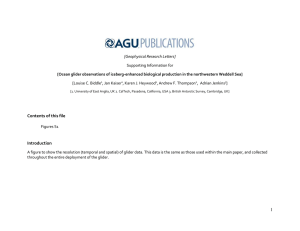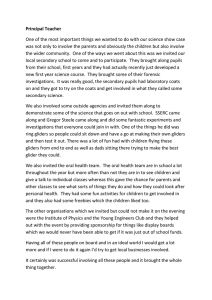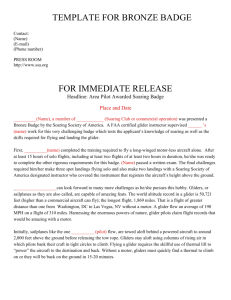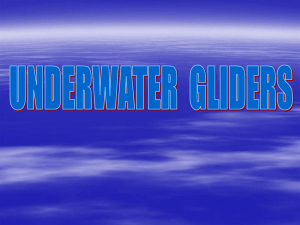Unmanned Mobile Sensor Net - Ben Snively
advertisement
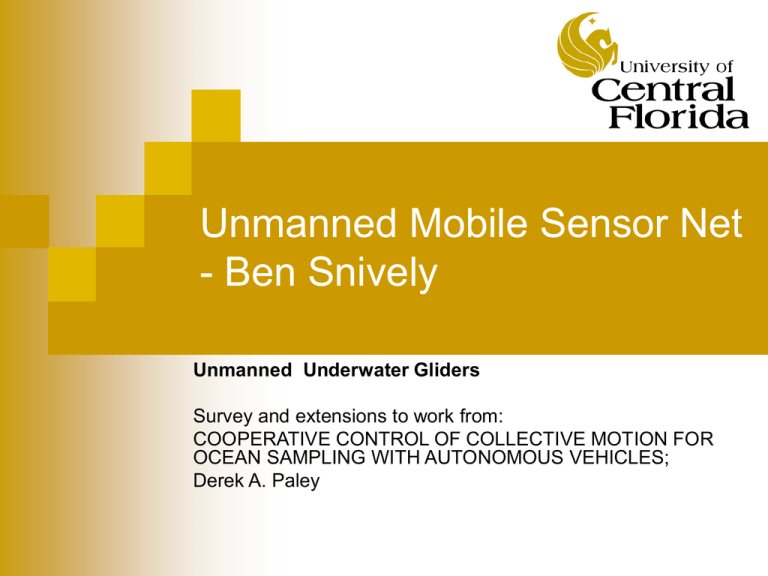
Unmanned Mobile Sensor Net - Ben Snively Unmanned Underwater Gliders Survey and extensions to work from: COOPERATIVE CONTROL OF COLLECTIVE MOTION FOR OCEAN SAMPLING WITH AUTONOMOUS VEHICLES; Derek A. Paley Problem / Motivation Manual Ocean Sampling labor, resource, and time intensive. Objectives/Sensing Gradient Climbing Feature Tracking Boundary Monitoring Perimeter Surveillance Mapping Autonomous Distributed Agents both reduce over costs, improve accuracy, and reduce latency for critical data. University of Central Florida Marine Sensing Equipment NOAA Manual Ocean Survey Ships with complex survey equipment Performs in both shallow and deep water collections. AUV – Autonomous Underwater Vehicle Shallow water survey using GPS and Satellite communication University of Central Florida Sensor Network Details Sink Satellite Communication Agents/Sensors Mobile Gliders Every Glider in Range of Sink / GPS Satellite only communicate with satellite when at surface Cannot control movement at surface (just floats) – has control only when submerged. GCCS – Glider Coordinated Control System GCCS steers groups/sets of gliders Gliders controlled remotely No Agenda/Beliefs/Planning University of Central Florida GCCS Overview “Apply a cooperative control methodology to control a fleet of autonomous underwater gliders. Underwater gliders soar through the water on a pair of fixed wings, collecting valuable oceanographic data for weeks at a time. We describe the Glider Coordinated Control System (GCCS), which steers multiple gliders to a set of coordinated trajectories. The GCCS automatically controlled up to six gliders continuously for over three weeks in a 800 km2 region in California’s Monterey Bay in August 2006. The GCCS enables oceanographers to specify and adapt glider sampling patterns with minimal human intervention.” (Paley) University of Central Florida Mobile Sensors and Sink University of Central Florida Domain Definition Domain: Outer Search Area University of Central Florida Domain Example <domain> <rectangle> <x> <units>deg</units> <value>-122.3817</value> </x> <y> <units>deg</units> <value>36.9765</value> Center Point Longitude Center Point Longitude </y> <a> <units>met</units> <value>20000</value> Width <units>met</units> <value>10000</value> Height <units>deg</units> <value>137</value> Angle </a> <b> </b> <ori> </ori> </rectangle> </domain> University of Central Florida Search Paths Tracks Search Paths University of Central Florida Tracks Example <tracks> <superellipse> <name>track1</name> <x> <units>deg</units> <value>-122.2713</value> </x> <y> <units>deg</units> <value>36.8950</value> </y> <a> <units>met</units> <value>10000</value> </a> <b> <units>met</units> <value>6667</value> </b> <ori> <units>deg</units> <value>47</value> </ori> <p> <value>3</value> </p> </superellipse> </tracks> University of Central Florida Shape/Name Center Point Width Height Glider Groups Glider Tree: Entities, which paths to use, Comm model. University of Central Florida Glider Groups Example <group> <group> <phase> <value>0</value> <units>pct</units> </phase> <glider> <mnf>w</mnf> <sn>7</sn> <model>e</model> <track>track1</track> <direction>1</direction> <phase> <value>0</value> <units>pct</units> </phase> <control> sellipse control </control> <!-- Manufacturer --> <!-- Serian Number --> </glider> <glider> . . . </glider> </group> </group> University of Central Florida <!-- Curve Phase --> YAES Simulations Simulations Performed 1. 4 Boundary Gliders rotating same direction 2. 4 Boundary and 6 Interior Sensors, All positioned in ideal/planned position. 3. 4 Boundary and 6 Interior Gliders, all starting from hub location Actual software from research done in Matlab. Software allows for both simulated and real tests University of Central Florida Background Information on Simulation XML Configurations drive simulation setup and context. Much like the Real system, xml configuration files define gliders, tracks, and other system configuration. (The XML Schema was slightly modified in order to simplify configuration) Main Simulation class allows for selection of which simulation to perform. JAXB used to parse XML Input / Java 1.6 SDK/Runtime (JAXB = Java API for XML Binding) University of Central Florida Simulation 1: Boundary Test Sink Communication at surface 4 Boundary Gliders University of Central Florida Simulation 2 : Interior Gliders 6 Interior Gliders covering Area 3 Groups, 2 Gliders in each. (Gliders communicate w/ Sink at Surface) University of Central Florida Simulation 3 : Boundary and Interior Gliders Sink Communication at surface 4 Boundary Gliders 6 Interior Gliders Flow adds error (off track) when Glider is at surface University of Central Florida Extending Network Current Limitations Central control/Planning Planning communication only done at surface (when gliders are floating and have no control – drift) Limited Inter-glider communication. Extending Sensor network principals to the system Gliders become agents with beliefs, agendas, and planning Sensor communication models and MDP principals (Specifically Partially Observable - MDP) This is critical due to the fluxations and inconsistencies in the robot control. University of Central Florida Glider Agents Key Difference Glider communicate with each other Goal: Glider has Agenda, Goal, and isn’t pure input/sensing device. Cover area (and plan) that has not been covered by other agents. Inform others plan/area covered. Single Sink transmitter could be at surface, to bridge underwater to satellite gap. University of Central Florida Planning / Decision Process PO-MDP (Partially Observable Mark-ov Decision Process. Outcome from Glider commands uncertain. Policy mapping between States / Actions Perceived new State. Routing issues isn’t applicable due to every glider having access to the sink (via satellite). Routing issues could be introduced in a more complex system where messages between gliders and to sink are transmitted. University of Central Florida Questions? Questions / Comments? Thank you. University of Central Florida
